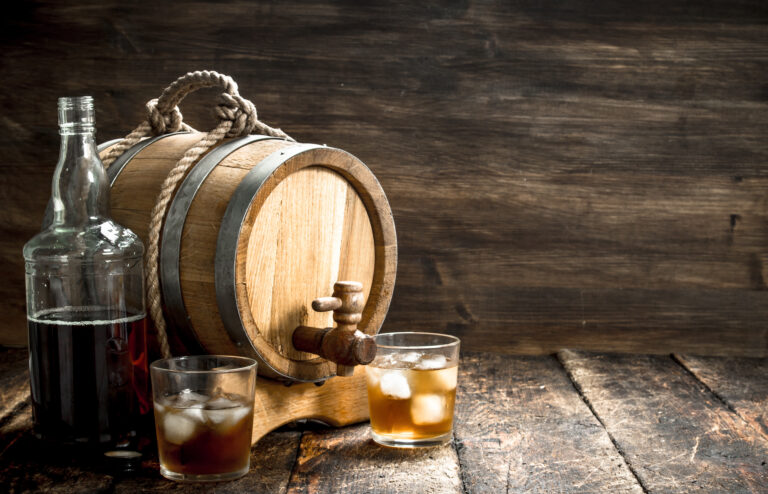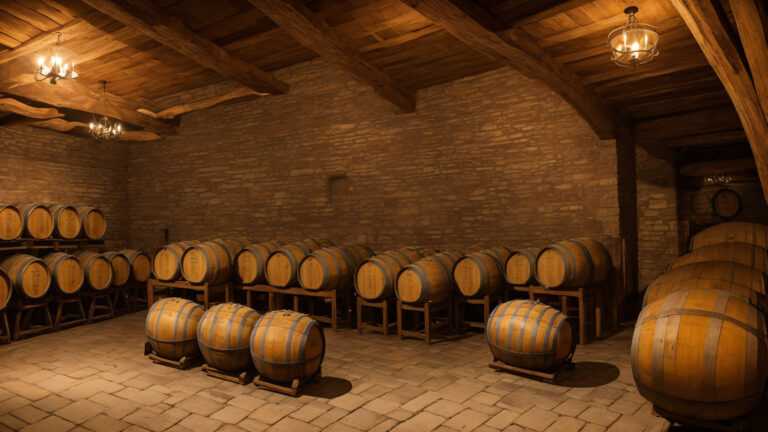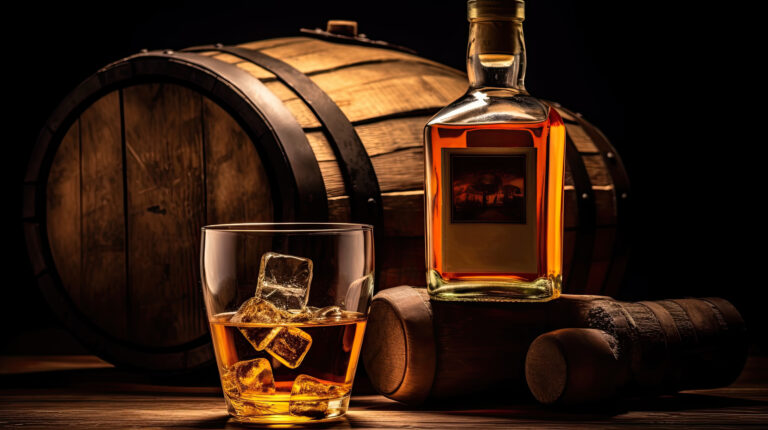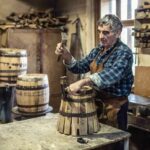Ever wonder what the heck is going on inside those big oak barrels as your favorite whiskey gets its groove on? It’s all thanks to a seriously cool phenomenon called the “angel’s share.” This isn’t just some poetic name; it’s the portion of whiskey that vanishes into thin air during the aging process. As the spirit chills out in the barrel, a little bit seeps into the wood and some evaporates right out. We’re talking about a slow-motion vanishing act that can take up to 5% of the total volume each year. I know, it sounds like a bummer, but trust me, this isn’t wasted whiskey. The angel’s share is the secret sauce behind that delicious flavor and complex aroma we all crave. Without it, your whiskey would be rough and one-dimensional. So next time you’re enjoying a perfectly aged whiskey, give a little nod to the angels who took their cut to make your drink so smooth and mellow. Their loss is absolutely our gain.
What Is the Angel’s Share?
The angel’s share is the amount of whiskey that evaporates while it’s mellowing out in oak casks. Picture this: the whiskey is just hanging out in the barrel, and a bit of it soaks into the wood while some of the liquid literally floats away into the air. That evaporated part? That’s the angel’s share.
The longer a whiskey ages, the more it gives up to the angels. After a bunch of years, the angel’s share can easily eat up half or even more of the original volume. A lot of distillers see this as a necessary trade-off to create a truly premium, aged spirit.
How much is actually lost depends on a few key things:
- The kind of oak: More porous wood is like an open invitation for evaporation.
- Barrel size: A bigger surface area means more liquid can escape, so smaller barrels lose whiskey faster.
- The weather: Hotter temperatures speed up evaporation, and humidity plays a role too.
- How long it ages: More years in the barrel means a bigger angel’s share.
While losing volume might sting a little, it’s what creates those smooth, complex flavors that aged whiskeys are famous for. The longer a spirit spends with the wood, the more character it soaks up. The angel’s share is what makes the whiskey that’s left over so worth every sip.
So, the next time you’re sipping an aged whiskey, raise your glass to the angels – seriously, without their share, your drink wouldn’t be nearly as fine. The angel’s share is a crucial part of the maturation process that gives whiskey its unique aroma, taste, and that beautiful amber color.
The Science Behind the Angel’s Share
Ever scratch your head wondering why whiskey barrels seem to mysteriously get less full over time? It’s not a leak or some wild ghost story – it’s actually a natural and essential part of the maturation process known as the angel’s share.
As whiskey ages in those beautiful oak barrels, a small bit of the liquid escapes as vapor through the wood. Typically, we’re talking about roughly 2% of the total volume each year. It might not sound like a lot, but after a few decades (or even centuries for some rare whiskies!), that loss really adds up.
The loss of whiskey to the angel’s share during maturation lets the remaining liquid’s flavors concentrate and helps with oxidation. As the volume drops, the whiskey’s flavor becomes more intense. The angel’s share also allows for oxidation, which changes the whiskey’s chemistry and overall flavor profile.
The type of oak used for the barrels makes a big difference, too. American oak barrels tend to have more porous wood, which means a higher angel’s share. European oak barrels are usually tighter-grained, so they lose less volume. And of course, the climate where the barrels are stored is a huge factor. Warmer temperatures crank up the evaporation, leading to a bigger angel’s share.
Even though losing that precious whiskey might feel like a shame, the angel’s share is absolutely necessary for creating the complex flavors and aromas that make aged whiskeys so damn good. So next time you enjoy an old, rare whiskey, give a toast to the angels – without them, it just wouldn’t taste the same!
Factors That Impact Angel’s Share Rates
The angel’s share is all about how much whiskey evaporates during barrel aging. A bunch of different factors decide just how much of that heavenly spirit slips away into the air.
Barrel Type The kind of barrel you use is a huge deal for evaporation rates. Smaller barrels have more surface area exposed to the air, which means more whiskey can escape. Larger barrels, which are super common for aging whiskey, have less interaction with oxygen, cutting down on the angel’s share.
Barrel Location Where the barrels are stored matters a ton. Barrels aged in places with serious heat and humidity are going to lose more liquid than those in cooler climates. Warehouses with barrels on the upper floors or close to the roof will be hotter, pushing more whiskey out of the barrel. Places with more airflow and ventilation also boost evaporation.
Length of Aging The longer whiskey ages, the more it’s exposed to all the environmental factors that cause evaporation. After a lot of years, a huge chunk of the original whiskey volume can vanish. We’re talking about potentially losing up to 50-70% of the original whiskey over 10-20 years of aging.
Alcohol Percentage Higher proof whiskies have less water in them, so there’s less water to evaporate. The more water there is in the whiskey, the more goes to the angel’s share. Standard barrel proof whiskies around 95% alcohol will lose less volume than those that go into the barrel at a lower proof.
Barrel Sealing How well the barrels are sealed also affects evaporation rates. Barrels that aren’t properly sealed will let in more air and cause higher losses. Tightly-grained oak and top-notch barrel construction help keep leaks to a minimum and more whiskey in the barrel.
Distillers have to keep a sharp eye on all these things to guess how much of their cherished whiskey might be heading heavenward during maturation. Careful barrel management and moderate aging conditions can help curb the angels’ thirst, leaving more of the final product to be bottled and enjoyed. But a certain amount of sacrifice to the angel’s share is just a non-negotiable part of getting those rich, complex flavors of aged whiskey.
Estimating How Much Whiskey Is Lost to the Angel’s Share
As whiskey matures in the barrel, some of the liquid evaporates. This is what we call the angel’s share. The amount that vanishes depends on a few key things:
- The barrel type. Barrels made from more porous wood, like American oak, let more whiskey evaporate. European oak barrels are less porous.
- The barrel’s char level. Heavily charred barrels mean more angel’s share. The char creates more surface area for the whiskey to interact with the wood.
- Environmental conditions. Whiskey aged in a humid, hot warehouse will lose way more volume to evaporation than whiskey aged in a cooler one. That extra heat and humidity really speed things up.
- How long it matures. The longer the whiskey matures, the more angel’s share is lost. After 12-15 years, a barrel can lose a crazy amount—up to 50-70% or even more of its original volume.
Figuring Out the Angel’s Share To get a rough idea of how much whiskey you might lose, think about the factors above. For example:
- A barrel of bourbon aged for 10 years in a hot, humid Kentucky warehouse could lose 50-60% or more of its volume.
- A barrel of single malt Scotch aged for 12 years in a stone warehouse in Scotland might only lose 30-40% of its volume because of the cooler climate.
- A barrel of rum aged for just 3 years in a tropical location could still lose 20-30% of its volume due to the intense heat and humidity.
The silver lining here is that even though a big chunk of liquid might be gone, the whiskey that’s left is usually incredibly complex and full of flavor. The angel’s share, while a bit of a bummer in terms of volume, is essential for creating a truly exceptional aged spirit. The loss of volume during maturation is simply the price we pay for a well-aged, finely crafted whiskey.
The Effects of the Angel’s Share on Flavor
As whiskey ages in barrels, some of the liquid evaporates—this is the angel’s share. While losing volume is a bit of a downer, the good news is that the angel’s share actually has a ton of positive effects on the flavor.
Evaporation Concentrates Flavor As the angel’s share happens, the whiskey remaining in the barrel gets more concentrated. This gives you a more robust and intense flavor. The water evaporates, but the flavor compounds stick around, creating a stronger, richer taste.
Oxygenation Boosts Aroma A tiny bit of oxygen sneaks into the barrel during aging. This subtle oxidation helps to develop the whiskey’s aroma and bouquet. As it mingles with the compounds in the whiskey, new aromatic compounds form, which gives aged whiskey its classic fragrance. The aroma becomes more complex and layered over time.
Wood Extractives Add Character The whiskey also soaks up compounds from the wood, like lignin, tannins, and terpenes. These “wood extractives” add notes of vanilla, nuts, and spice. They make a huge difference to the whiskey’s taste and finish. The longer a whiskey ages, the more character it gets from the barrel.
While the angel’s share might mean less whiskey in the end, what’s left behind is a more flavorful, fragrant, and memorable spirit. The evaporation loss is a necessary step in the journey from raw distillate to a premium aged whiskey. The angel’s share is really a blessing in disguise, responsible for developing the rich and nuanced flavors that make aged whiskey so delightful.
Attempts to Reduce Angel’s Share Losses
One trick distilleries use to try and cut down on the angel’s share is to use oak casks with thicker wood and a tighter grain. The thicker the wood and tighter the grain, the less oxygen can get in. Charring the inside of the casks before filling them with whiskey also helps create a barrier.
Choosing a spot with a cool, controlled climate for aging whiskey can also lower evaporation rates. Storing casks in a warehouse with minimal temperature swings and high humidity slows down both water and alcohol evaporation. Some distilleries have even found that aging their whiskey in coastal areas, where the ocean helps keep temperature and humidity steady, reduces the angel’s share.
Rotating and Repositioning Barrels Moving barrels around in the warehouse and repositioning them periodically exposes different parts of the barrel to the air. This helps the whiskey mature evenly, but it also allows more oxygen to get in, which actually increases the angel’s share. Minimizing barrel movement can help curb losses, but it might mean the whiskey doesn’t mature as evenly.
Using Smaller Barrels Aging whiskey in smaller barrels, like quarter casks or octaves, speeds up maturation because of the larger surface area to volume ratio. Whiskey can reach the same level of maturity in just a few years that might take decades in larger casks. However, the smaller the barrel, the faster the water and alcohol can evaporate. Distilleries have to find a sweet spot between using small barrels to age faster and not losing too much to evaporation.
Even though losing some whiskey to the angels is unavoidable and even desirable, distilleries are getting creative with new techniques to tighten up their barrels and get more control over evaporation. Reducing the angel’s share means more aged whiskey to bottle, but it’s a careful balancing act. Too little evaporation could mess up the quality and flavor. With better barrel-making, warehouse design, and barrel management, distilleries are finding ways to keep more whiskey in the barrel to reach its full, mature potential.
The Role of Angel’s Share in Pricing and Valuation
The angel’s share is that whiskey that evaporates from the barrels during maturation. As the spirit hangs out in the barrels, a small amount escapes through the wood into the air—this vaporized whiskey is known as the angel’s share. While it might seem like a waste, the angel’s share is actually a huge factor in how aged spirits are priced and valued.
The longer whiskey ages, the more angel’s share it loses from evaporation. Since there’s less whiskey left in the barrel, the remaining spirit gets more concentrated with flavor and aroma compounds, making it rarer and higher quality. This is why aged whiskey costs more.
The climate where the barrels are aged also affects how much angel’s share is lost. Hotter temperatures speed up evaporation, while cooler ones slow it down. Whiskey aged in Scotland or Ireland might lose about 2% a year, compared to 4-6% a year in Kentucky’s warmer climate. The location of maturation is a key factor in a whiskey’s taste profile and price.
Barrel selection is also important. Barrels made of wood with a tighter grain, like oak, allow less evaporation than those with looser wood. The barrel’s char or toast level also matters; more char means a larger surface area and higher evaporation. Carefully choosing barrels to balance angel’s share loss with imparting flavor is a real art form for distillers.
The lost volume from the angel’s share means there’s less whiskey to bottle and sell, so distillers have to factor this loss into how much spirit they put into barrels in the first place. The potential revenue lost to the angel’s share is built into the final price of the bottled product. This is how the phenomenon of the angel’s share shapes how aged spirits are valued and priced on the market.
Even though the angel’s share might look like wasted whiskey, its role is vital. From concentrating flavor to impacting the price, the angel’s share makes aged spirits a rare treat and helps turn whiskey into liquid gold. The next time you enjoy an aged single malt or bourbon, raise your glass to the angels who made it so precious.
Angel’s Share Regulations Around the World
When whiskey is aged, some of the liquid evaporates. This is the angel’s share. The amount that vanishes depends on things like humidity, temperature, air circulation, and the type of barrel used.
Regulations on the angel’s share are different in various countries and regions. In Scotland, distilleries typically lose about 2% of the whiskey volume each year during aging. Distillers are allowed to top off the lost volume to make sure they have enough to bottle.
In Ireland, distillers also lose around 2% per year to the angel’s share. However, they aren’t allowed to replace any of the lost volume. So, what goes into the barrel is all they get out. This puts a limit on how long Irish whiskeys can be aged.
In America, the rules are set by the Alcohol and Tobacco Tax and Trade Bureau (TTB). Distillers lose a bit less, around 0.5-1% each year, thanks to the cooler climate. The TTB does allow distillers to add water to replace the angel’s share and bring barrels up to their original bottling proof. Some craft distillers choose not to replace any lost volume to really highlight the effects of aging.
Those angels really do love their whiskey! While distillers around the world might lose a portion of their precious spirits to evaporation during maturation, the regulations are there to keep quality standards high and make sure everything is fair. The reward for patience—a well-aged, complex whiskey—makes the angel’s share worth the cost.
Regulations offer guidance, but ultimately, the story of each whiskey is a testament to the care, creativity, and craft of the distiller. The angel’s share is a natural part of that story. Let’s raise a dram and toast those thirsty angels!
The Phenomenon of Angel’s Share During Whiskey Maturation FAQs
As whiskey matures in barrels, a portion of the alcohol evaporates. This is what we call the angel’s share. Here are a few common questions about this phenomenon:
Why does the angel’s share happen?
Alcohol is volatile, meaning it evaporates easily. As whiskey sits in barrels, a small amount seeps through the wood into the air. Environmental factors like temperature, humidity, and air circulation also play a big role in how much is lost.
How much whiskey is lost to the angel’s share?
On average, about 2% of the whiskey in a barrel evaporates each year. So, for a barrel aging for 10-15 years, roughly 20-30% of the original whiskey can be gone. The exact amount really depends on the specific barrel and aging conditions.
Does the angel’s share change the flavor of whiskey?
You bet. As the lighter, more volatile stuff in the whiskey evaporates, the remaining liquid has a higher concentration of the heavier, more flavorful compounds. This is what helps create those awesome tastes we love in aged whiskeys, like oak, vanilla, and dried fruit. The loss of alcohol also makes the whiskey smoother.
Can anything be done to reduce the angel’s share?
Some distillers use specially treated or charred barrels that are less porous, which slows down evaporation. They can also store barrels in cooler parts of the warehouse. But a certain amount of angel’s share is necessary for proper maturation and to get the best flavor. Trying to eliminate it completely would result in a less complex, less interesting spirit.
While the angel’s share might feel like a waste of good whiskey, it’s a crucial part of the maturation process. The transformation it brings, enriching the flavor and mellowing the spirit, is well worth the loss. The angel’s share gives aged whiskey its distinctive and irreplaceable character.
Final Thoughts
So there you have it—a deep dive into how the angel’s share impacts whiskey during maturation and why it’s so critical to the flavor profiles we all know and love. While it might seem like a loss on the surface, the truth is that without the angel’s share, we wouldn’t have aged whiskey as we enjoy it today. Those complex flavors and aromas only develop because of that interaction between the spirit and the air in the barrel over time. The next time you sip an aged whiskey, take a moment to appreciate the angel’s share—it’s the reason that first taste is so incredibly satisfying. The loss of volume is a small price to pay for liquid gold.







